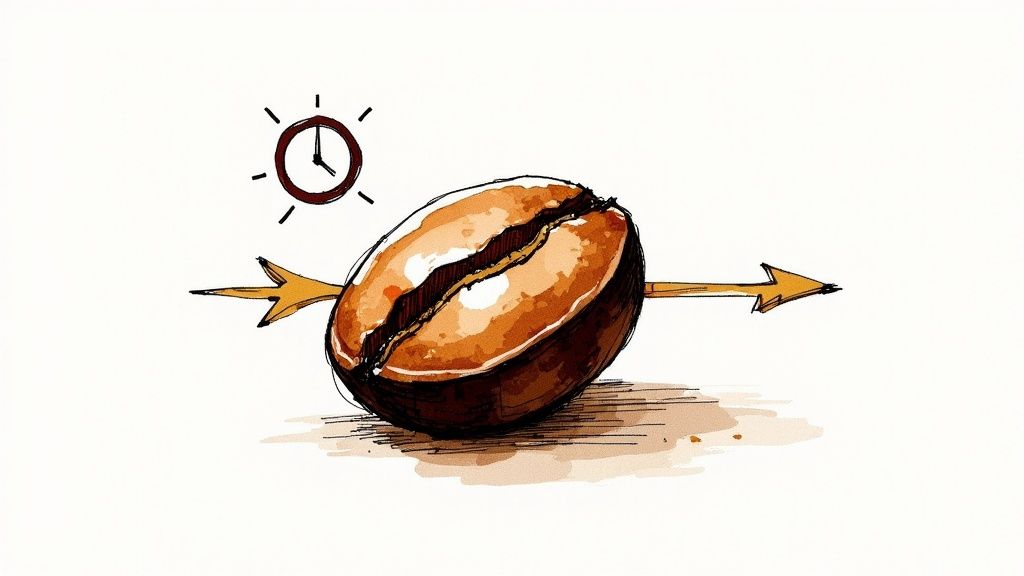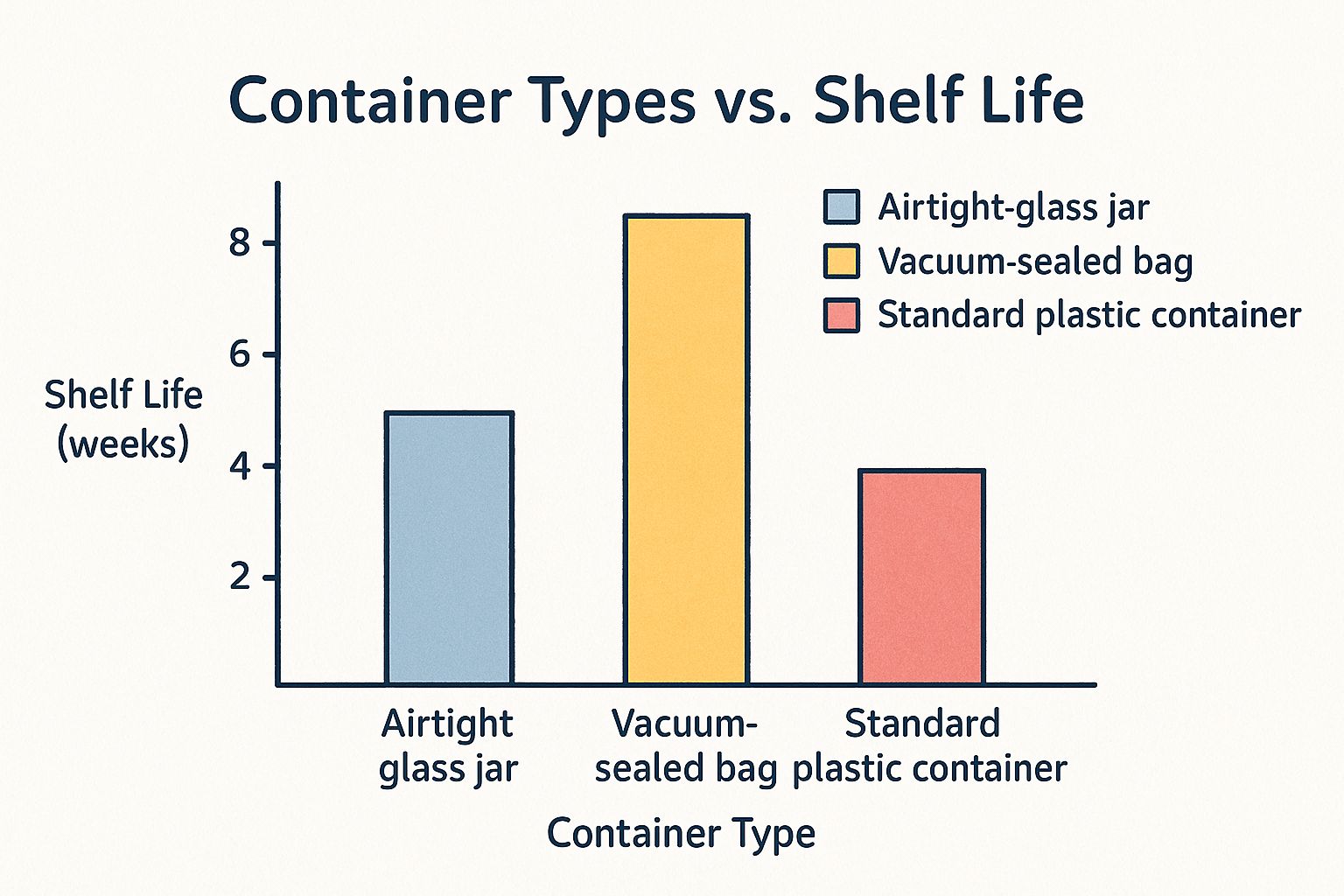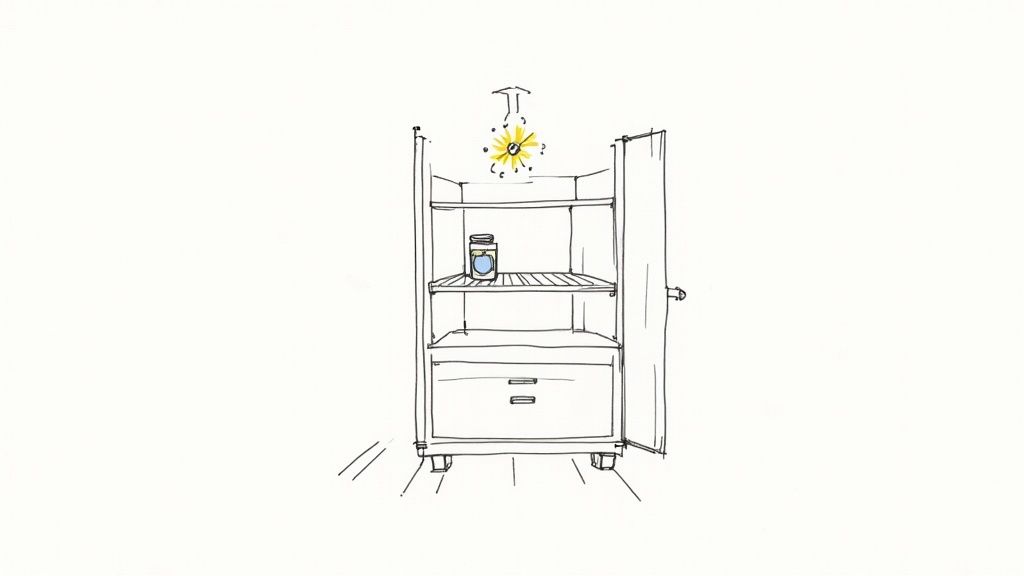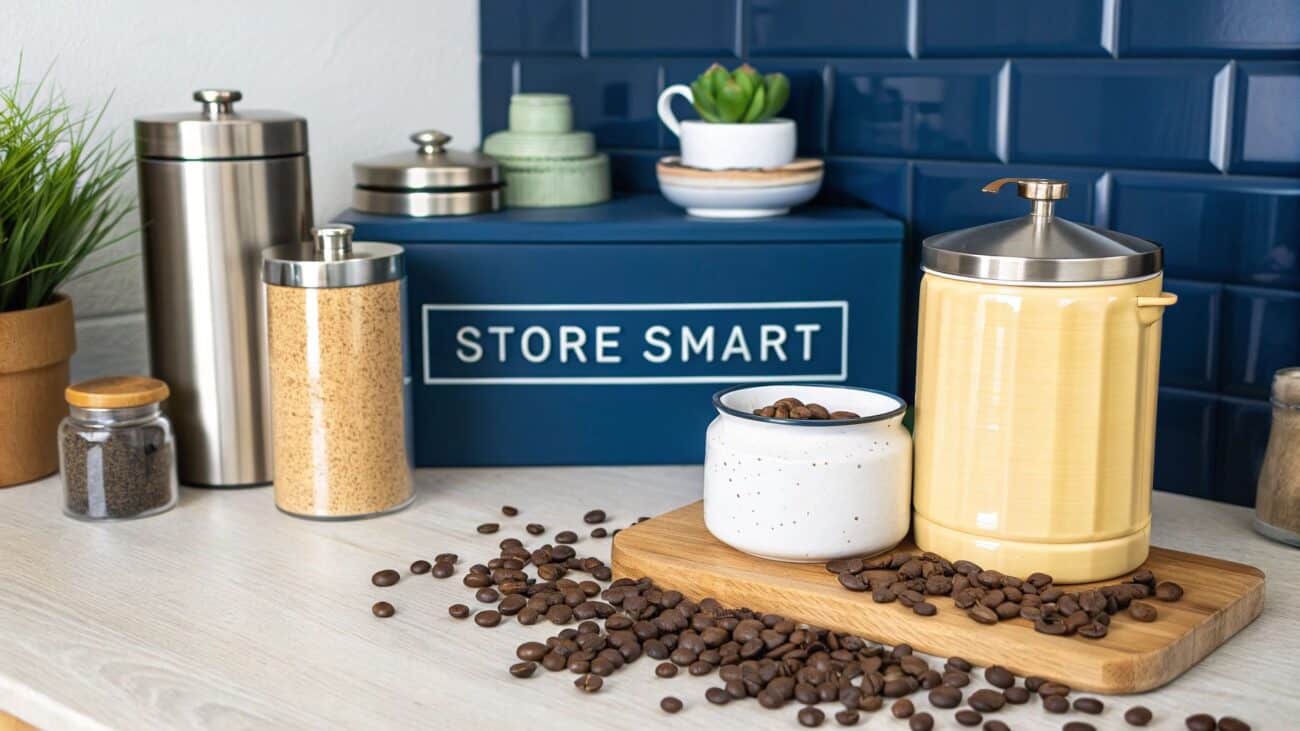How to Store Coffee Beans for Maximum Flavour
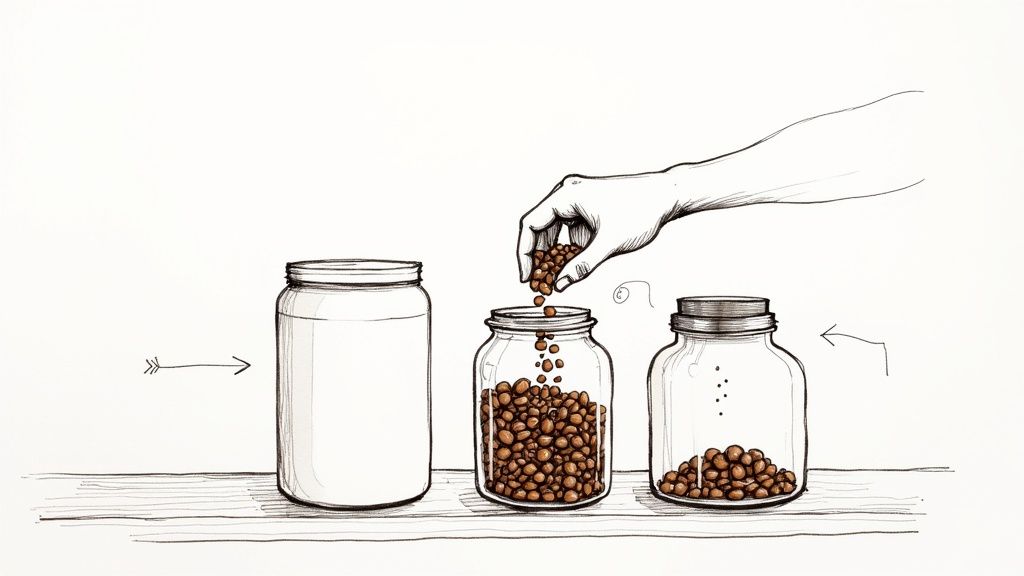
To get the most out of your coffee, you need to store it properly. The golden rule is simple: keep your beans in an airtight, opaque container at room temperature. Make sure it's well away from heat, light, and any moisture. This one small habit prevents your beans from going stale, protecting those delicate oils and making sure every single cup is packed with rich, vibrant flavour.
Why Your Coffee Storage Method Matters
Have you ever brought home a bag of incredible coffee, only to find it tastes disappointingly flat just a week later? It’s a common frustration, and the problem usually isn’t your brewing technique; it's how you’re storing the beans.
The moment those beans leave the roaster, they begin a race against time. Poor storage just speeds up the process of them losing their magic.
Coffee beans are packed with delicate, volatile oils and aromatic compounds. These are responsible for the complex notes you love, whether it's the bright citrus of an Ethiopian Yirgacheffe or the chocolatey richness of a Brazilian Santos. The catch is, these compounds are extremely sensitive.
The Four Enemies of Fresh Coffee
When you're figuring out how to store coffee beans, your main job is to shield them from four key culprits that are always trying to steal their flavour. Knowing your enemy is the first step towards a better brew.
- Oxygen: This is public enemy number one. Oxidation is a chemical process that makes coffee go stale, much like how a cut apple turns brown. It breaks down the fats and oils, leading to a loss of aroma and a dull, almost cardboard-like taste.
- Heat: Warm environments are a disaster for coffee because they accelerate chemical reactions, especially oxidation. Storing beans near an oven, a radiator, or even in direct sunlight will degrade their quality in no time.
- Light: Direct sunlight and even strong artificial light can be surprisingly damaging. UV rays break down the complex organic molecules that give coffee its unique flavour profile, leaving it tasting lifeless.
- Moisture: Coffee beans are porous, meaning they absorb moisture and odours from the air around them. This not only ruins the flavour but can also create an environment ripe for mould growth.
A common mistake I see all the time is people displaying their beans in a beautiful clear glass jar on the kitchen worktop. It looks lovely, I get it. But this exposes them to both light and fluctuating temperatures, which is basically a recipe for a truly bland cup of coffee.
From Bean to Brew
Think of each coffee bean as a tiny, sealed capsule of potential flavour. Your job is to preserve that potential until the moment you brew.
By choosing the right storage method, you’re making sure the intricate flavours developed during roasting actually make it into your mug. This is especially true when you invest in high-quality specialty coffee beans, as their unique, delicate characteristics are always the first to fade.
Ultimately, proper storage isn't just some trivial step; it's a fundamental part of honouring the journey of the bean—from the farm right through to your kitchen. Get this part right, and you'll be rewarded with a consistently delicious and aromatic brew, every single morning.
Choosing the Right Coffee Storage Container
Now that we know what wrecks fresh coffee, let's talk about the first line of defence: your storage container. Think of it as a personal bodyguard for your beans. Its one and only job is to shield them from oxygen, light, heat, and moisture, making sure the amazing flavour the roaster worked so hard to create actually makes it into your cup.
The container you pick is arguably the most important decision in your whole coffee storage strategy. A great canister can seriously extend the life of your beans. A bad one—like that pretty-but-useless clear glass jar on the worktop—can make them stale in just a few days.
What Makes a Great Coffee Canister?
When you’re hunting for the perfect home for your beans, a few features are completely non-negotiable. The best containers are built specifically to fight off those four flavour-killers we just covered, so keep your eyes peeled for these key traits.
- An Airtight Seal: This is the absolute must-have. A proper seal stops oxygen from creeping in and starting the dreaded oxidation process. Look for containers with chunky silicone or rubber gaskets that create a solid, dependable closure.
- Opaque Material: Light is a serious enemy. Your container has to be opaque to block out damaging UV rays. This immediately rules out any clear glass or plastic, no matter how stylish it might look.
- A One-Way CO2 Valve: Freshly roasted beans release carbon dioxide in a process called degassing. A one-way valve is a clever feature that lets this CO2 escape without letting any oxygen in. You'll find them on high-quality coffee bags and the best specialised canisters, and they do wonders for preserving the beans' integrity.
This image shows just how much your choice of container impacts the shelf life of your beans.
As you can see, a vacuum-sealed container can more than double the freshness window compared to a standard airtight jar. It really highlights the massive difference removing oxygen makes.
Coffee Storage Container Material Showdown
The material your container is made from plays a massive part in how well it protects your coffee. Different materials offer different levels of protection against the elements. To help you decide, here’s a quick showdown of the most common options.
| Material | Effectiveness Against Enemies | Things to Consider | Ideal For |
|---|---|---|---|
| Stainless Steel | Excellent. Completely blocks light and air. Very durable. | Can sometimes be pricey. Look for a quality airtight seal. | The serious home barista who wants maximum flavour protection. |
| Ceramic | Very Good. Opaque and provides good insulation against heat. | Can be fragile if dropped. The quality of the lid's seal is crucial. | Style-conscious coffee lovers who want effectiveness and aesthetics. |
| Opaque Glass | Good. Blocks light, but effectiveness depends entirely on the seal. | Cheaper options often have poor-quality lids. Can shatter. | A budget-friendly choice, as long as you find one with a genuinely airtight seal. |
| Plastic (Opaque) | Fair. Can be airtight and opaque but may absorb odours over time. | Can retain coffee oils and smells, potentially tainting future beans. | Short-term storage or for travelling, but not the best long-term solution. |
Ultimately, stainless steel and ceramic are the top contenders for keeping your beans in peak condition. They offer the most robust defence against coffee’s biggest enemies.
Finally, think about the container's size. You want one that just fits the amount of coffee you typically buy. Why? Any extra air left inside the container will still contribute to staling. The less empty space, the better.
By matching the container to your buying habits and paying close attention to the roast date—which is heavily influenced by different coffee roasting profiles explained here—you’ll set yourself up for a consistently brilliant brew, every single time.
Finding the Perfect Spot in Your Kitchen
So, you’ve got the perfect container—that’s a huge win. But where you put that container is just as critical. The right spot in your kitchen is the final piece of the puzzle in the daily battle for freshness.
Too many people unknowingly sabotage their beans by choosing a convenient spot over the correct one. Let's bust a few common myths and find the perfect home for your coffee.
The Ideal Environment for Freshness
The golden rule for storing coffee is simple: keep it cool, dark, and dry. Think of your beans as little vampires—they absolutely despise sunlight and heat.
Your best bet is a kitchen cupboard or pantry, tucked away from any heat sources. Avoid the obvious culprits like the cupboard next to the oven, on top of the fridge (where heat vents out), or near a radiator. You’ll also want to keep them well away from any windows where direct sunlight can bake the container and degrade the delicate oils inside.
Temperature stability is everything. Constant swings between hot and cold will stress the beans, create condensation, and speed up the staling process in a hurry.
The sweet spot for coffee storage is generally between 10°C and 20°C. A standard room-temperature cupboard, far from your appliances, fits this brief perfectly, ensuring those precious flavours are preserved.
The Great Fridge and Freezer Debate
Ah, the age-old question that divides coffee lovers: should you refrigerate or freeze your beans? The short answer is, for the most part, no. But there are some very specific exceptions, particularly if you're thinking long-term.
The main problem with the fridge is moisture. Coffee beans are porous and act like little sponges, soaking up moisture and any stray odours. Storing them in the fridge means they get hit with condensation every time you open the door—a fast track to ruined flavour. Nobody wants coffee that tastes of last night's curry.
Freezing, on the other hand, can be a viable strategy, but only if you do it with extreme care. This isn’t a casual storage solution; it's a method best reserved for bulk buys when you know you won’t be touching the coffee for several weeks or even months.
How to Freeze Coffee Beans Correctly
If you're going to commit to freezing, you have to follow the process to the letter to avoid a flavour disaster.
-
Portion Before You Freeze: Before they go anywhere near the freezer, divide the coffee into smaller, weekly-use portions. This stops you from constantly thawing and refreezing, which will absolutely destroy the beans.
-
Use a Vacuum Sealer: This part is non-negotiable. You have to remove every last bit of oxygen to prevent freezer burn and oxidation. If you don't have a vacuum sealer, sucking the air out of a zip-top bag with a straw is a decent DIY alternative in a pinch.
-
Thaw Completely Before Opening: This is the crucial final step. When you're ready to use a portion, take the sealed bag out of the freezer and let it come all the way to room temperature before you even think about opening it. If you open it while it's still frozen, condensation will instantly form on the cold beans, and all your hard work will be for nothing.
Think of the freezer as a time capsule. It hits pause on the staling process, but once those beans are thawed, the clock starts ticking again, often faster than before. And whatever you do, never, ever refreeze coffee that has been thawed. For daily use, that cool, dark cupboard remains the undisputed champion for anyone wanting the best possible taste from their beans.
Common Coffee Storage Mistakes to Avoid
We’ve all been there. Despite our best intentions, it’s frighteningly easy to fall into a few common traps that silently chip away at your coffee's flavour. Getting coffee storage right is often less about learning new tricks and more about unlearning a few bad habits.
Let’s walk through some of the most frequent slip-ups I see. Think of these not as rules, but as simple adjustments that will make a world of difference to your morning brew. Spotting these small mistakes is the first step towards a consistently delicious cup.
Leaving Beans in the Original Bag
It's tempting, I get it. You just want to roll up the top of the bag your coffee came in, stick a clip on it, and call it a day. While some brilliant bags from speciality roasters have zip-locks and one-way valves, most of the standard paper or foil bags you'll find just aren't truly airtight once you’ve torn them open.
Oxygen is the enemy here. It will creep in, and those beautiful beans will start tasting stale within just a few days. The easiest fix is to move your beans into a dedicated, opaque, and airtight container the moment you get them home. Honestly, this one change alone is a massive defence against oxidation.
A classic scenario is buying a lovely bag of artisan beans and leaving it on the worktop for convenience. But that paper bag gives almost zero protection from air or light, meaning you’re literally losing flavour with every passing hour.
Displaying Beans in a Clear Glass Jar
We’ve all seen it on Instagram: a stunning clear glass jar filled with glossy coffee beans, sitting proudly on a kitchen shelf. It looks incredibly stylish, but this is one of the fastest ways to kill your coffee. Direct sunlight or even the bright lights in your kitchen will fast-track your beans to a dull, lifeless brew.
Those UV rays break down the delicate oils and aromatic compounds that give coffee its incredible character. Your best bet is always an opaque container, something made of ceramic or stainless steel. If you’re really attached to that glass jar, no problem—just tuck it away inside a dark cupboard instead of leaving it out in the open.
Grinding the Entire Bag at Once
Grinding your whole bag of beans for the week might feel like a genius time-saver on a busy Monday morning, but it massively speeds up the staling process. As soon as you grind coffee, you increase its surface area exponentially, exposing all those precious flavour compounds to the air.
In fact, ground coffee can start losing its freshness in as little as 15 minutes. This is why so many coffee lovers in British households swear by the golden rule: store whole beans and grind only what you need, right before you brew. It's not just coffee snobbery; the difference in aroma and taste is truly night and day. If you want to dive deeper into the nation's coffee habits, you can discover more insights at Working From Coffee Shops.
And if you're getting serious about unlocking the best flavour from your beans, you might even be curious about our guide on how to roast coffee beans right at home.
Advanced Storage Tips for Coffee Enthusiasts
So, you've got the basics down. Your precious beans are safely tucked away from their four mortal enemies. Now, it's time to get a bit more serious and explore the techniques that separate a good home brew from a truly exceptional one.
One of the most crucial, yet often misunderstood, parts of the freshness puzzle is something called degassing. As soon as they leave the roaster, coffee beans start releasing a whole lot of carbon dioxide (CO2). That one-way valve you see on fancy coffee bags is there for this very reason—to let the gas out without letting any oxygen in.
But here’s the thing: brewing coffee that’s too fresh, say just a day or two after roasting, can actually backfire. The intense CO2 release interferes with how the water extracts flavour, often leading to a sour, underdeveloped taste. You need to give your beans a little time to breathe. A rest period of 3 to 7 days post-roast is the sweet spot, allowing the degassing to stabilise and setting you up for a much more balanced and delicious cup.
Portioning for Peak Freshness
If you're like me and love buying bigger, more economical bags from your favourite artisan roaster, you've got to protect that investment. My go-to strategy is to divide the whole bag into smaller, weekly portions the very day it arrives. This simple act drastically reduces how often the bulk of your beans are exposed to damaging oxygen.
Want to take it a step further? Get a vacuum sealer involved. It's a game-changer.
- Seal Your Weekly Stash: Pop each week's supply into its own vacuum-seal bag and suck all the air out.
- Keep One Out, Freeze the Rest: Your current week's portion goes into an airtight canister in the usual cool, dark spot. The other sealed bags can go straight into the freezer.
- Long-Term Preservation: This method protects them from moisture and freezer smells, keeping them in perfect suspended animation.
This technique essentially creates a time capsule for your coffee's flavour. It means the beans you use in a month's time will taste almost as vibrant as the ones you brewed on day one, preserving those delicate single-origin notes.
"Every day coffee is frozen at -18°C is roughly equivalent to 90 days at room temperature. This isn't just about avoiding stale coffee; it’s about preserving a specific moment of peak flavour."
By getting a handle on degassing and adopting a smart portioning strategy, you take complete control of your coffee's life cycle. This level of care is what elevates your brewing from a routine to a craft. For those who really want to chase the ultimate fresh cup, exploring home coffee roasting equipment is the final frontier.
Your Questions on Coffee Storage Answered
Even with the best advice, a few specific questions always seem to pop up when people are dialling in their coffee storage routine. To help you feel completely confident, we’ve tackled some of the most common queries we hear from our fellow UK coffee drinkers.
How Long Do Coffee Beans Actually Stay Fresh?
For whole beans, you’ll find the peak flavour hits somewhere between two and four weeks after the roast date. Once you crack open the bag, it’s best to use them within a fortnight to really enjoy them at their best.
Ground coffee is a completely different story. It loses its aroma and vibrant flavour so much faster, sometimes tasting noticeably stale in just a few days. Always look for the roast date on the bag—it's a far more reliable guide to freshness than any "best before" date.
Of course, a good storage routine is only half the battle. Knowing how to brew coffee properly ensures you make the most of those fresh beans. Check out our guide on brewing coffee for some top tips.
Is Storing Coffee Beans in the Freezer Really That Bad?
It certainly can be, so this is a method that needs a bit of caution. The number one enemy here is condensation. Any moisture is a disaster for roasted coffee beans.
Freezing should only ever be a last resort for the long-term storage of a completely unopened, vacuum-sealed bag. When you decide to use it, let the entire bag thaw to room temperature before you even think about opening it.
If you open it while the beans are still frozen, moisture will instantly condense on them, undoing all your careful preservation work. And whatever you do, never, ever refreeze coffee beans. The constant temperature changes will completely destroy the delicate oils and compounds that give coffee its amazing flavour.
Can I Just Use the Bag the Coffee Came In?
This really depends on the bag itself. A high-quality bag from a speciality roaster will often have a one-way degassing valve and a sturdy zip-lock seal. This kind of packaging is usually perfectly fine for short-term storage, maybe for a week or two after you’ve opened it.
But the standard paper or thin foil bags you often see just aren't properly airtight once they're open. For consistently fresh coffee day in and day out, your best bet is always to transfer the beans into a dedicated airtight and opaque container.
At Seven Sisters Coffee Co, we believe that exceptional coffee begins with the freshest beans. Explore our curated selection of single-origin and blended coffees to experience the difference that quality and care make in every cup. Visit us at https://sevensisterscoffee.co.uk to find your next favourite brew.

